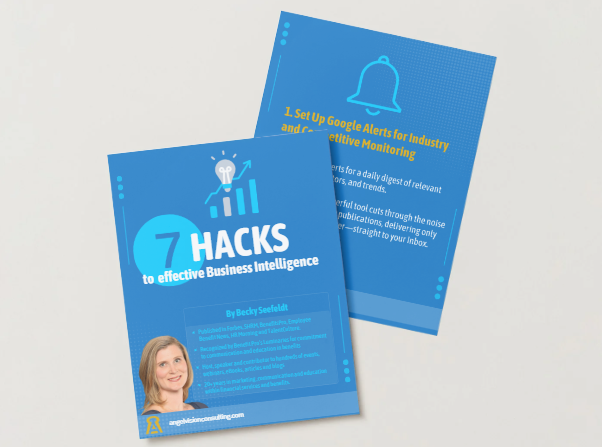7 Hacks to Efficient and Effective Business Intelligence
Over the years, I've developed and refined a set of strategies for staying ahead in my industry and keeping an eye on the competitive landscape. Today, I’m sharing my best-kept secrets.
1. Set Up Google Alerts for Industry and Competitive Monitoring
Whenever I discover a new competitor, legislative update, industry influencer, or emerging trend, I set up Google Alerts for a daily digest of relevant insights. This simple but powerful tool cuts through the noise of countless industry publications, delivering only the updates that matter—straight to my inbox.
2. Learn from Broader Consumer Trends
Highly regulated industries like finance, benefits, and insurance may lag behind in innovation, but that doesn't mean we can't anticipate changes. Studying consumer trends beyond our immediate space—such as those driven by Apple, Amazon, OpenAI, or Google—can offer valuable foresight into market shifts. Ask yourself:
- What strategies are these innovators using to engage customers or remove friction?
- How can similar approaches be applied to your business?
3. Track Recurring Research and Industry Benchmarks
History provides powerful clues about where the market is headed. Many industries have key reports that are published annually, offering consistent insights for long-term strategic planning. Some of my go-to reports include:
- Devenir HSA Survey (Twice per year—tracks HSA industry growth)
- KFF Employer Health Benefits Survey (Annually in October)
- Mercer Health & Benefits Strategies Report (Typically annual)
- HRA Council Growth Trends Report (Newer analysis on ICHRA and QSEHRA expansion)
4. Follow Competitor Activities on Socials and Newsletters
One of the most straightforward ways to understand your competition is by seeing how they present themselves. Following competitors on social media and subscribing to their newsletters can provide valuable insights into their messaging and positioning.
For a deeper perspective, consider looking at employee reviews on Glassdoor or other platforms to gauge company culture and customer experiences. Of course, all intelligence gathering should remain ethical and transparent.
5. Leverage Personal Experience for Competitive Insights
Over the years, I’ve interacted with various vendors, solutions, and benefits providers. These experiences offer a goldmine of lessons:
- How was the customer experience?
- Were there communication gaps or inefficiencies?
- What could have made the interaction smoother or more engaging?
Reflecting on these encounters can uncover strategies for improving your own offerings.
6. Dig Into Your Own Data
Your company’s data contains hidden gems that reveal customer behaviors and opportunities for optimization. Consider analyzing:
- Customer inquiries (What are their most frequent concerns?)
- Usage patterns (What features are underutilized—and why?)
- Customer sentiment (What feedback are they sharing about your brand?)
This insight enables proactive adjustments to meet customer expectations.
7. Stay Ahead with Direct Industry Sources
Why wait for second-hand reports when you can be the first to know? Subscribe to direct industry sources for immediate updates:
- Legislative developments (Set up saved searches & alerts on Congress.gov)
- Regulatory releases (Sign up for IRS email alerts on IRS.gov)
- Professional associations (Industry groups & lobbying firms provide exclusive insights)
Intelligence is a Habit, Not a One-Time Task
Business intelligence isn’t about gathering data once (or even once a year)—it’s about building habits that keep you informed, adaptable, and ahead of the competition. By consistently tracking industry trends, analyzing your own data, and staying connected to key sources, you create an ongoing advantage that positions you for success.
The best part? Intelligence compounds. The more you engage with these strategies, the sharper your insights become.



